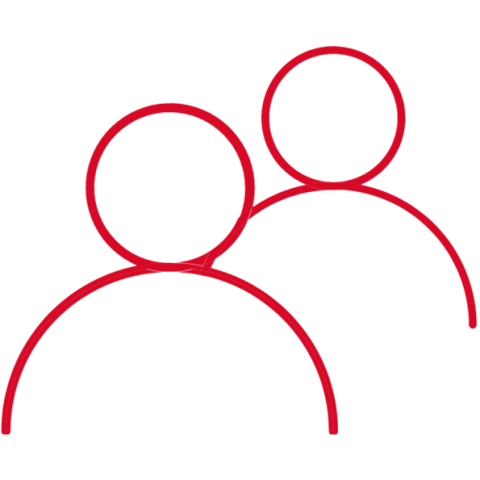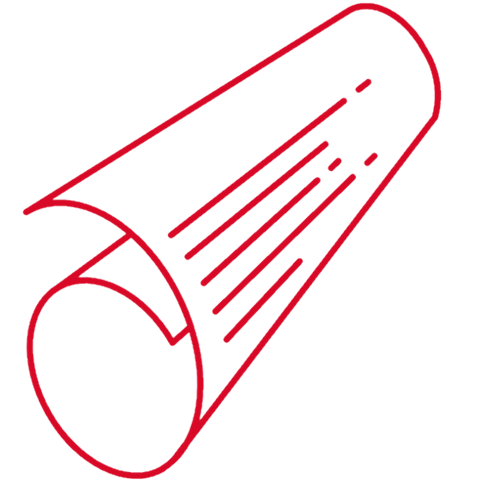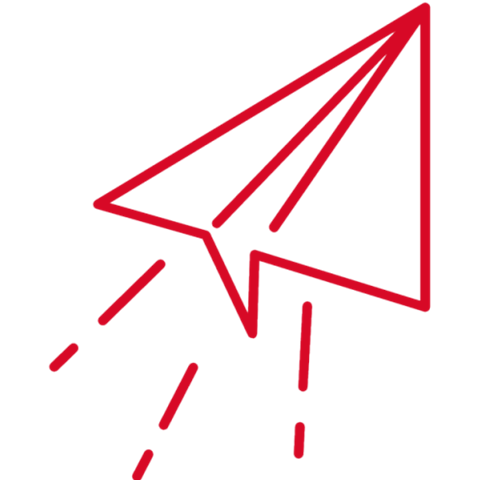Chemistry is for life - not just for Xmas *and the puppy agrees!
17 Dec 2024
Chemistry can feel like magic, something intangible that makes creating great work possible - with everyone working together, challenging each other for the better and working through the inevitable challenges with passion, hunger and drive. But as any team who’s lost that all-important spark knows, good chemistry is crucial if relationships are going to shine not only in that first year, but in years 2, 3, 4, 5 and beyond (oh yes!).
When thinking about chemistry over the long term, Vicky Gillan - who helps brands and agencies drive high-performing partnerships - is reminded of a chat with her Nana, where she was told in no uncertain words that “a dog is for life, not just for Christmas”. Despite numerous requests and letters to Santa, it was decided that a Girls World was a much better choice (you know the one, whose hair magically got shorter and longer at the push of a button?)
So when her twin boys begged and pleaded for a puppy of their own for their 10th Christmas, adamant after weeks of relentless questioning that they would of course take turns feeding, walking, playing, clearing up, picking up poo - she said yes. The joy of giving what she never had was magical, as was the look on their faces, but fast forward a couple of years and, oh my, did she hear her Nan’s voice loud and clear. Well after the initial excitement had faded, she was greeted with the inevitable teenage response of “later” to all and any requests of “walk your dog”!
If a working relationship can be characterised as a puppy, and the client/agency its respective new owners, everyone needs to prepare for when all the Christmas decorations have been put away and we’re facing walks in the lashing rain; the cuteness overload a distant memory and BAU very much alive and kicking.
For this article, Vicky was joined by Tony Spong (AAR’s Brand Strategy Lead Consultant, who oversees our agency seminar programme and brand pitches) to discuss chemistry over the long term. They both see examples of amazing chemistry in their daily roles, and share today what helps or hinders, what makes chemistry flourish or fade; and what ensures all parties still enjoy walking their dog in good weather, and the not-so-good weather too.
Three types of chemistry
Chemistry exists in, between, and around everything: across roles, levels of seniority, and between teams both in-house (think brand and commercial) and agencies - like creative and client service, planning and data. Factors like clarity, ambition, talent, ways of working, project size, ambition, timelines, quality of brief (amongst others) can ALL influence chemistry and affect (to borrow a phrase from Gen Z) the “vibes” between teams. But vibes can be tricky to see, trickier to measure and often their absence is only noted when the vibes turn bad.
According to Vicky, there are three kinds of chemistry - but what's the impact on the work and outcomes in tangible terms? The nuances are often difficult to see or explain, but in her 15 years of assessing client/agency relationships, Vicky has identified signs that she always looks out for. They encompass what is said and unsaid, considering both the HOW and the what of marketing. So what does good, bad and indifferent chemistry look like? And where are you on the “journey”... "Step Into Christmas" by Elton John, anyone?
Positive Chemistry: The Seamless Spark
Looks Like:
-
Your teams are so in sync that roles and boundaries feel invisible. Everyone is chasing the same goal.
-
There is a steady flow of ideas, fueled by curiosity and creative tension, where differences spark better outcomes instead of conflict.
-
You share a “we’ve got this” attitude that turns challenges into opportunities.
Feels Like:
-
The atmosphere is energised and buzzing. You have a sense of momentum and excitement with every conversation and meeting, whether that’s a face-to-face catch-up or casual chat over Slack/Discord/WhatsApp.
-
Both parties feel psychological safety, allowing for dynamic conversations and open disagreements that push the work forward without personal tension.
-
Mutual admiration: both sides are inspired by, and respect, each other’s expertise.
Impact and Consequences:
-
Breakthrough ideas that just surprise and delight, options, scenarios. No hierarchy or bureaucracy.
-
Resilient teams that handle setbacks with grace and bounce back stronger.
-
A real feeling of ‘we've got this’. WE are working together, not US and THEM. Teams going the extra mile when chemistry fuels their drive.
The Proof in the Pudding:
-
Teams with strong chemistry and collaboration are 4 times more likely to deliver “highly creative” campaigns that perform above industry benchmarks (Source: Contagious).
-
Brands that foster close, collaborative relationships with agencies are 2.5 times more likely to outperform their competitors in market share growth (Source: WARC).
Neutral Chemistry: The Missed Opportunity
Looks Like:
-
You have a polite but distant partnership: the work gets done, but the spark is missing.
-
There is a lack of healthy tension, with too much agreement or avoidance of difficult conversations.
-
There is minimal overlap between teams, with little curiosity about each other’s challenges or perspectives.
Feels Like:
-
Functional but uninspired—a sense of “it works, but so what?”
-
A low-buzz atmosphere where team interactions feel transactional rather than collaborative.
-
Frustration below the surface as missed opportunities to innovate or challenge go unspoken.
Impact and Consequences:
-
Safe but dull (or easily forgettable) outputs that meet expectations, but fail to stand out.
-
Reduced team satisfaction and motivation—people do their jobs, but the joy is missing and no one wants to spend time together.
-
Stagnant performance, with no push to go beyond the brief or challenge the status quo. A warning phrase: “We tried that - it didn't work.”
- Blame culture starts to become more and more evident…
The Proof in the Pudding:
- Campaigns are 24% less effective when agency and client relationships are rated as merely "adequate" by team members (Source: IPA).
Negative Chemistry: The Costly Disconnection
Looks Like:
-
You are experiencing misaligned priorities, poor communication, and siloed efforts.
-
There is an atmosphere where conflict lingers unresolved, while tension flairs and disrupts progress.
-
Very formal with little natural flow. Everything takes so long to be delivered, and the process is painful.
Feels Like:
-
Your teams are drained and demotivated. There’s a “work to rule” mentality where teams disengage.
-
People are standoffish and defensive, with blame-shifting instead of problem-solving.
Impact and Consequences:
-
Missed deadlines, rework, and campaigns that often don't meet KPIs/ OKRs.
-
Fractured trust that is leading to wasted time, renegotiating or even giving work to other agencies (on the roster).
-
Declining brand performance due to inconsistent or underwhelming outputs.
The Proof in the Pudding:
-
Cannes Lions State of Creativity report for 2024 suggests that 45% of agency/client relationships are ‘strained.’
-
Poor agency-client relationships lead to a 30% reduction in campaign ROI compared to partnerships rated as strong (Source: Effie).
Keeping up the Positive Chemistry
Here’s AAR’s 4-step plan for success, or at least getting chemistry assessment on the radar and the ball rolling.
- Plan Proactively
As summed up by Vicky Gillan, “I don’t want us to get into hindsight. I want us to get into foresight”. If a relationship is to thrive, the initial excitement should be followed up immediately with plans to cultivate continuous improvement and a radar system put in place to actively talk about and track chemistry. Be open about where you are now. And make it a talking point, at least every 6 months, to assess. Get into the details across and between the different roles, levels and teams. Be open and honest.
Anticipate and prepare for the longer term by planning for the inevitable - such as personnel changes, the common “itch moments” and external challenges - by scenario planning. And crucially facilitate smooth transitions and the same level of quality immersion to all new joiners - client or agency.
Take the time early in the relationship for a 100-day Health Check to assess the current state of play and identify issues that may already be beginning to form - ensuring that good chemistry prevails and is not already turning to neutral or negative as the team comes together. This gives you an external, objective check-in and a roadmap for course correction that can keep the client AND agency to account, mindful of actions that help chemistry flourish and sparkle.
- Interact Intentionally
One of the key requirements for good chemistry, according to Tony Spong, is protecting against “chemistry dilution” - where expanding teams means time is increasingly stretched across growing numbers of people. Being aware of the great relationships in your team - the connectors where sparks fly when they are together - is the first step in making sure that magic continues to flow rather than dissolve. You want meetings to feel more like ‘collaboration’ occasions rather than show-and-tell ‘committees’.
As we all know, gone are the days of regular lunches between brand and agency leaders, but time together is crucial and a real chance to focus on opportunities for mutual growth. Think workshops or collaborative projects to strengthen bonds between teams - iterating intentionally with a purpose and goal that links to the ambition and road map.
Be curious about one another, adapting to new individuals to understand how they prefer to work, their knowledge, their experience and their view of good chemistry.
- Communicate Communicate Communicate
It’s vital to remember that lack of communication breeds uncertainty and erodes trust (and chemistry) incredibly quickly. Mess-ups last far longer in our minds than anyone realises. If things are changing, or under review, whether that’s people, strategic direction, budgets, stakeholders and senior leaders - make sure the other teams know - and all at the same time. There’s nothing worse than hearing second-hand news.
This is particularly important in regard to unpleasant news, with Tony remembering a client who, upon belatedly finding out that a key member of the agency team was moving on, reported feeling nervous about what else the agency might have planned and when. And that feeling lasted for years - well until they parted ways and even then it was raised in the pitch briefing. It is far better to prepare collaboratively and ensure loss of personnel doesn’t equal loss of knowledge and momentum. Build in time for handovers and chemistry sessions.
- Shape Shared Stories
Regular “wash-ups” help teams evaluate their performance and create shared stories by asking key questions:
- What has been achieved?
- How have we worked together?
- What were the successes?
- Where is there room for improvement?
Regular evaluation and open dialogue about continuous improvement should instead be part of your team’s culture. As Vicky emphasises, “Don’t be an ostrich. Don’t put your head in the sand. Lean into hard conversations. See change as an opportunity to say we know we can do better, here's our ideas.” It's so crucial to have those hard conversations constructively and openly. Niggles can be so easily nipped in the bud when they are still small, and as AAR research shows, it’s crucial to do so if we are to change the dial on stats like these.
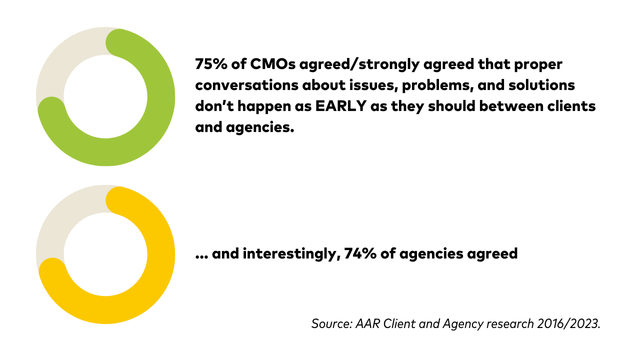
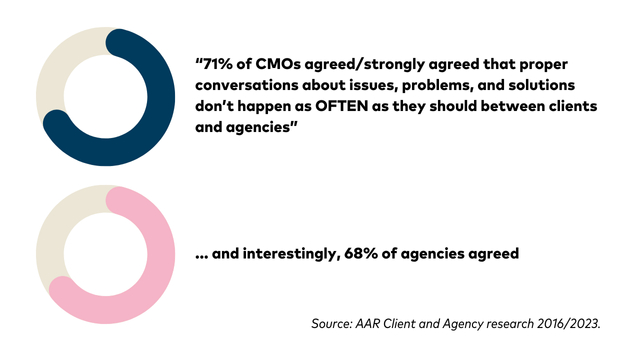
Time to get your sparkle back?
If good chemistry has been lost, it doesn’t mean you can’t get it back. Creating the right conditions for chemistry means getting very honest, very quickly - and that's hard when you’ve got into a negative place and are still delivering the day job. But it’s never too late for a positive Reset if both parties are up for it and open to some external support.
So if you're reading this and thinking ‘Yep, this is ringing some bells. We’re in the negative zone or heading there’; come and have a confidential 30-minute chat. Together we can explore tangible actions to bring the magic and sparkle back with our Chemistry Reset 6-week programme.
And on that final note, a Happy Christmas to you all from Vicky and Tony. And to anyone getting a new puppy, good luck and enjoy every beautiful second🎄🐾
